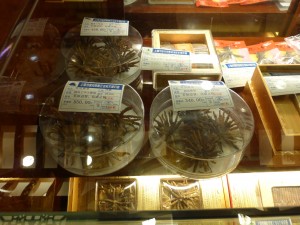
Western Doctor: What are your symptoms?
Chinese Doctor: How are you feeling?
Western Doctor: What is your temperature and blood pressure?
Chinese Doctor: How is your energy?
Western Doctor: Take these tablets three times a day for one week. Call me if you’re not better in seven days.
Chinese Doctor: Drink this tea each day for two weeks and concentrate on seeking balance. Come back in after two weeks and let’s see where your energy is.
The Philosophy of Traditional Chinese Medicine
Chalked up to a combination of being raised on Southern favorites made with too much Crisco and sugar; trying every dish under the sun as we moved around; and learning to live with a lackadaisical standard of cleanliness in food consumption has made my stomach an enemy of state to my body. My symptoms are in line with Celiac Disease. To spare you the messy details, we’ll just say when attacks occur, it’s not pretty.
At the height of the symptoms, I sought out treatment through Traditional Chinese Medicine as I wanted to experience a new form of medical care. I was seen and treated at the Body & Soul Medical Clinics, a mix of Western and Chinese doctors specializing in TCM. While I’ve been treated at the facility, I have learned and experienced a lot about this ancient form of medicine and health.
To start, there are two overarching concepts provide the basis of the practice:
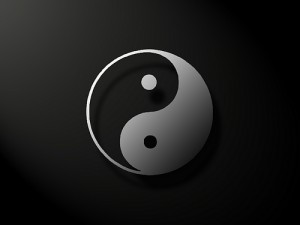
1. Yin & Yang
When I was in middle school, I loved to draw the Yin & Yang symbol. Half of my pre-teen jewelry collection had something to do with this emblem, but I really had no idea what it meant. It just looked cool.
After visiting the Body & Soul Medical Clinics and speaking with Dr. Doris Rathgeber, the general manager, it was explained to me, in the medical sense, as “inseparable forces that complement and depend on each other.” (As I have also learned in the spiritual sense, it can also mean there is good and evil in everyone.)
The Yin, the darker half, represents the inner source and the more female attributes. Organs classified in the Yin property include the liver, heart, spleen, lungs and kidneys. These are considered “solid and are occupied with the production, preservation and regulation of the body’s basic substances.”
The Yang, the lighter half, depicts the outer source and the more male characteristics. Organs in the Yang property include the gall bladder, small intestine, stomach, large intestine, urinary bladder, and major glands that work together with the lungs, spleen and kidneys to disperse liquid in the body. Characteristics of these organs “are hollow and have the task to receive, discern and excrete the body substances.”
Both halves make up the whole existence of a person, and when an ailment occurs, the halves are out of proportion.
As part of this concept is the relationship between blood and qi, or the life energy. The most important substances in TCM, they work together to form the physical, mental and spiritual body. “Qi represents the active energy Yang, and blood represents the passive energy Yin.”
2. The 5 Elements
As in nature-bound philosophies, there are organic elements that affect our sense of well-being. In TCM, these elements correspond to a major organ system in the body:
- Wood – Liver
- Fire – Heart
- Earth – Spleen
- Metal – Lung
- Water – Kidney
As these natural elements interact in a constant motion with each other, the body’s systems depend on each other for health. When they are out of sync with each other, disease occurs. Treatment consists of balancing these elemental systems.
Diagnosis with Traditional Chinese Medicine
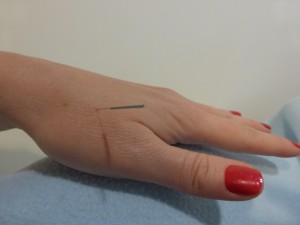
In Western medicine, the body is observed and diagnosed in separation. If there is a problem with your foot, then just your foot is observed and treated. You take a Tylenol table for a headache and a Pepto-Bismol dose for your stomach. In the East, the body is considered as one energy system acting in a dynamic interaction with all elements. All of it must be considered to diagnose the problem.
In my first consultation at the clinic, the doctor observed my overall appearance, asked about my daily eating and sleeping habits, and performed a tongue and pulse measurement.
It is believed in TCM that the appearance of the tongue can speak to the functions of the inner body. On the back of the tongue, conditions of the kidney, bladder and intestines are shown; the right and left sides of the tongue are connected to the gallbladder and liver; the middle of the tongue relates to the symptoms of the stomach and spleen; and the tip of the tongue presents the case of the lungs and heart.
The pulse is checked in the hands and wrists. This diagnostic test tells the doctor about various workings in the body, such as energy levels, presence of dehydration and/or retention, and the possibility of blockages.
Treatment with Traditional Chinese Medicine
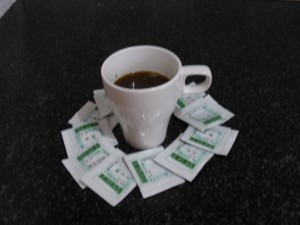
I (try very hard to) drink a Chinese medicinal herbal tea every morning. It’s absolutely disgusting. I was informed, though, the TCM belief is the more bitter the taste, the better it works. Mine should be working miracles then.
Herbs and organic powders are highly regarded in TCM for their healing properties. My morning tea consists of powders from plant-based ingredients such as rhizoma atractylodis and semen ziziphi spinosae. Other powders can come from insects, bird excretions, bones and horns.
I was also prescribed a series of acupuncture sessions to realign my qi along certain meridians in my body. TCM is all about balance, be it between the Yin and Yang, the 5 elements, blood or qi. In acupuncture small needles are used to open and redirect meridians so the qi can flow more freely. In my sessions, needles were placed in the top of my head, between my thumb and forefinger, around my navel, and the bottoms of my legs. The pain was minimal, with the sorest point being my hands, which I was told was most aligned to my stomach. Heating lamps were then placed above the needles, and I was left to rest with the needles in place for about 45 minutes at each session.
Other treatments I’ve read and been told about include cupping, placing warm cups on the skin to create suction that encourages blood flow; gua sha or scraping, using the horn of an animal to brusquely move across the skin to draw toxins out; moxibustion, the burning of mugwort applied directly or indirectly to the skin to promote the movement of cold spots and warm meridians; and various massage techniques that target meridians and unique problem areas.
Exercise in Traditional Chinese Medicine
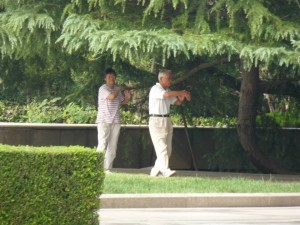
What we call exercises in the West actually have a much deeper spiritual and medical rationale in the East. These movements, such as Yoga and Tai-Chi, were developed as a means to prepare or treat the body in spirit as well as physicality.
Participating in a Tai-Chi class in China and Yoga in the States, I have learned how the gentle and fluid movements help with a multitude of physical abilities, such as flexibility and joint health, while these practices promote mental balance through meditation qualities. It’s also a plus that Tai-Chi is basically martial arts in slow motion.
West v. East?
When I follow the prescribed treatments in my TCM regiment as directed (I’m not the greatest patient), I can very much see and tell the difference in my body’s reaction to foods and my mental wellness. However, I still want my direct, in-and-out, to-the-point Western diagnosis and fix-me-up-quick treatment. The goal now is to combine these two forms to find a balance.
What style do you prefer? Would you be willing to try the Eastern version of medical care?
-Monica
